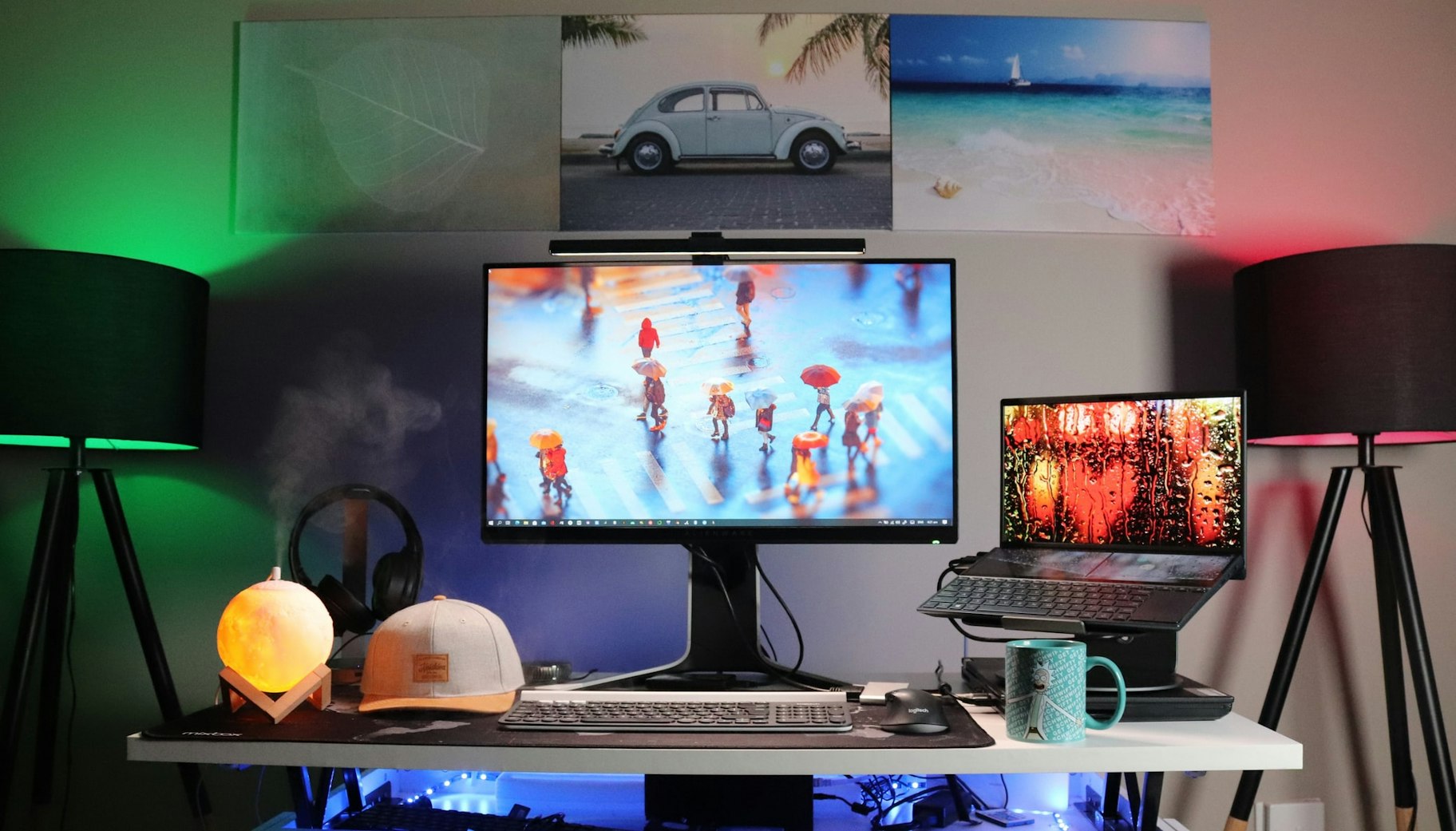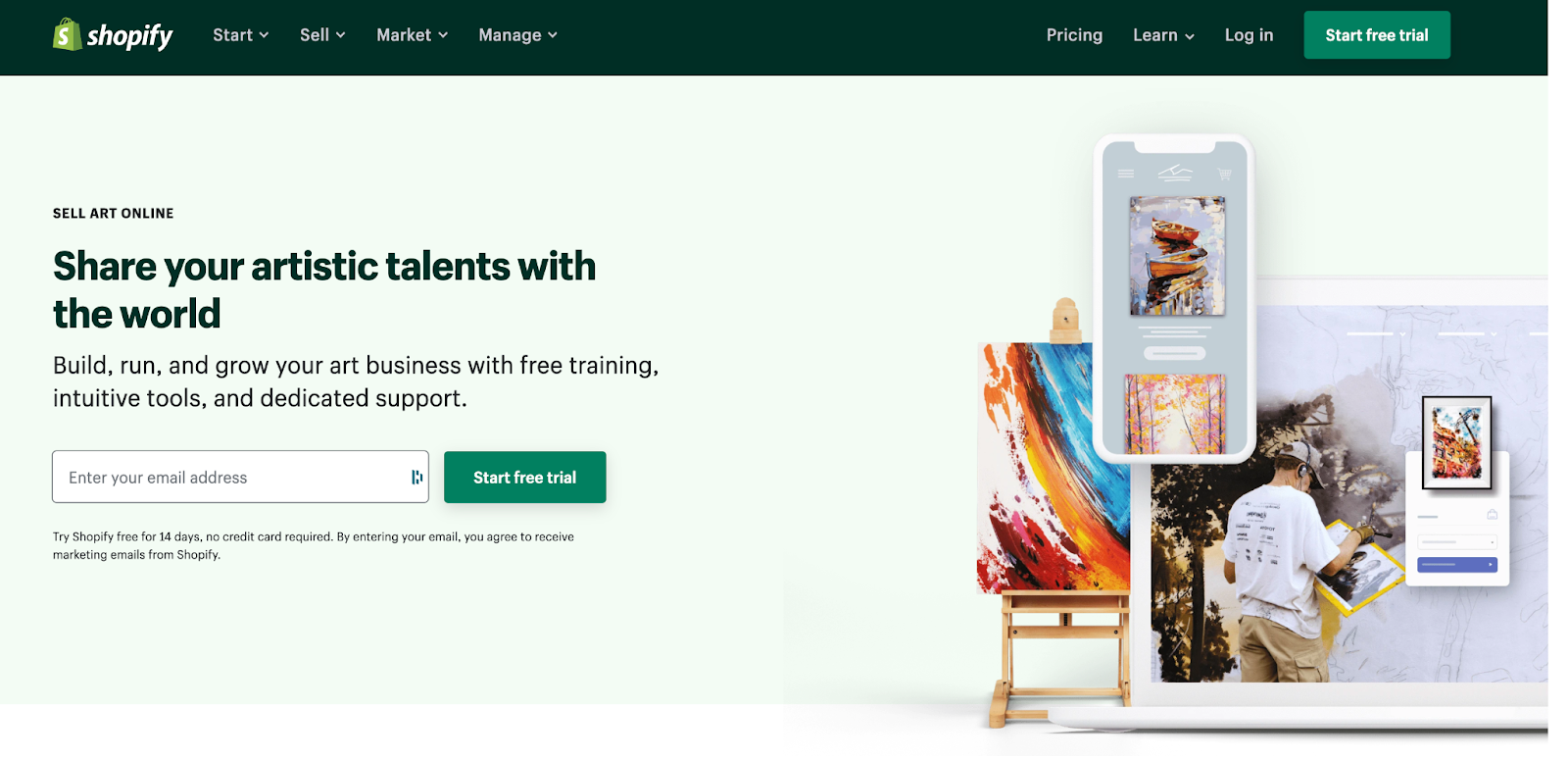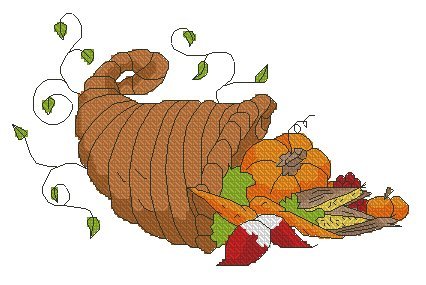Want to learn how to sell art online?
Good idea! Selling art is an incredible way to make money doing what you love. People all over the world are prepared to spend on creative art prints and designs, with the global art market worth around $50 billion.
Fortunately, with all of the tools now at your fingertips, you can set up an online art store to showcase your prints and merchandise and begin accepting payments from people all over the world with ease. While a gallery showcase is still a great way to promote your works, the online market represents a huge opportunity to reach larger audiences.
Whether you’re a beginner artist just dipping your brush into some new sales avenues, or you’ve been a creative mastermind for years, here’s how you can sell your art online in 8 simple steps.

Don’t wait for someone else to do it. Hire yourself and start calling the shots.
How to Sell Art Online: 8 Steps to Success
1. Original or Reproductions? Take Your Pick
One of the first decisions you’ll need to make when selling artistic pieces online is where you’re going to focus your business. As an artist, you may choose to sell reproductions of your creations (like prints), curated pieces (from other artists), or originals.
Some entrepreneurs sell a combination of different art types to attract a wider audience. Your options include:
- Original works: Drawings, paintings, and other original artworks designed by you. You can sell prints and reproductions of these artworks too.
- Limited-edition prints: You might sell a certain number of prints for a limited time to generate more interest in the items.
- Custom art: These are artworks generally designed after a client commissions something from you. For instance, you might create drawings of a person’s dog or best friend. These pieces are usually one-of-a-kind.
- Merchandise: Thanks to print-on-demand companies, it’s easy to place your designs on all kinds of t-shirts, enamel pins, and more.
- Licensing: You can license certain works to other companies, like photography or illustrations designed for another brand.
- Digital downloads: Templates, desktop wallpapers, artworks people can bring at home, and other digital downloads are popular (and cheap to sell).

2. Make Your Prints
If you decide to create original works and produce prints, you’ll need to find the best way of creating your prints. Fortunately, there are a lot of options here. If you have the right printing machine at home, you can create DIY prints in high-quality inks and on all kinds of beautiful paper.
DIY printing can be a good way to keep profits high if you’re worried about spending too much as a beginner artist. If you can’t afford a professional printer at home, you can potentially use a local printing service every time someone makes an order. As order numbers increase, you can consider using printing companies online to reproduce your work in higher volumes.
Print-on-demand is another option for keeping costs low. The cool thing about print-on-demand is you can print on a lot more than just paper. Companies in the POD landscape allow you to print your works on canvases, metal, and even accessories, like bags and mugs.
3. Digitizing Your Work: Photography vs Scanning
Digitizing your art for online selling can be tough. As you may know, simply snapping a photo of your latest work might not be the perfect way to demonstrate all the details of your piece accurately. Photos can leave a shine on images or cause colors to appear a little different from their shade in person. Everything from your lighting to camera choice will impact the quality of your photos.
Here are a few tips to follow when photographing and scanning your art:
- Take multiple pictures: Take clear shots from multiple angles and zoomed-in pictures to show detail and texture. Lifestyle photos (such as your artwork on a bedroom wall) are excellent for making an emotional impact on your audience
- Edit images: Recalibrate the picture once it’s digitized using contrast, brightness, and other settings to make it look as true to life as possible. Avoid using any filters or additional features that might make customers uncertain about what they will get.
- Crop images: Remove unnecessary edges and background elements unless you’re providing a contextual shot. Make sure hands and extra props aren’t visible, as they can detract attention from your piece.

Remember to save images in the right format too. PNG images often hold onto high resolution and clarity much better than JPEG files.
Pro tip: For flat or 2D images, it’s often best to use scanning, as the scanning machine can carefully examine and upload images pixel by pixel.
4. Get the Pricing Right
Pricing is one of the toughest parts of starting your own business. Choose a price too high, and you risk scaring away customers. Price something too cheap, and you convince your audience they’re not getting the best quality — it’s a fine balance
Pricing original art is particularly tough, as it’s difficult to place value on your skill. If you’re just getting started and don’t have many followers or fans, you might want to start with simple pricing. For instance, combine your time and labor costs with material costs and expenses. Add a small markup at the end to give yourself a profit. Once you have a better sense of demand for your art and have amassed a following, then you could consider charging a premium. Also, think about your competitors and the kind of prices they offer. Should your fees be lower or higher?
If you’re selling curated art or prints, pricing becomes a little simpler. All you need to do is take the cost of printing and add on the fees of selling and marketing the print, as well as your markup (profit). You might charge a slightly higher price for limited edition prints.
Pay attention to your competition and marketplace to see what kind of prices your customers tend to respond best to. Don’t be tempted to undervalue yourself just to attract more customers; you need to make a profit to make your endeavor worthwhile. Check out these pricing strategies to better understand how much to charge for your art prints or merchandise.
5. Create Your Online Store
It’s finally time to create and launch your online store.
You can build a store in a matter of 30 minutes with a solution like Shopify. This ecommerce site-building service comes with everything you need to showcase your art and start making profits. You can customize a theme to suit your brand image, set up a checkout page, and even add apps to help you sell your art.

Shopify's app market comes packed full of tools to make life easier for creative professionals. For instance, there are:
- Email marketing tools: These are great for keeping your customers up to date on your latest pieces, generating hype about new collections, and even providing information to clients about their previous orders.
- SEO solutions: SEO apps help with keyword research and tracking to ensure you can boost your visibility online. If you want your customers to find your art when searching for certain terms on Google, you need SEO.
- Print-on-demand apps: If you’re selling art merchandise and want to work with another printing company to mass-print your products, print-on-demand services will be a great blessing. Make sure you choose a POD service you can trust to produce high-quality products for your customers.
Shopify also has a range of free applications, like countdown timer apps if you want to create a sense of urgency and convince people to buy. Everything you need to supercharge your online store is available in the Shopify App Store.
6. Explore Additional Platforms for Online Selling
If you really want to boost your chances of getting as many sales as possible, then you’ll need to sell on more than just your own website. There are dozens of art-focused marketplaces online with pre-existing customer bases, making it easier to find potential buyers. Options include:
- Etsy: Probably the best-known site for artistic creations and crafting. Etsy is an online marketplace where you can list your art alongside other local and global creators.
- CafePress: A solution for turning your art into unique products and collectibles, CafePress helps you to unlock new formats for your art. You can also get your pieces featured in front of a huge potential audience.
- ArtFire: Similar to Etsy, Artfire is a marketplace for makers and crafters around the world. Artfire helps you capture your target audience’s attention with things like podcasts, articles, and more.
- eBay: If you’re selling one-of-a-kind creations, eBay might be a good choice for you. This is the world’s largest auction site, where people have the option to bid exactly what they think your piece is worth.
- Artfinder: Artfinder is a dedicated marketplace for curated artwork. You’ll need to apply to the site if you want to be featured. There are tons of seller plans available and various commission options to consider as well.
- UGallery: Aiming to democratize art selling, UGallery connects artists directly with collectors. This is an excellent site to consider if you’re selling one-of-a-kind pieces. The website has an application process to ensure all art sold through the site maintains a high standard.
You can also consider selling directly through social media channels like Facebook, Pinterest, and Instagram. Alternatively, look into wholesale sites like Handshake to sell photos and prints in bulk.
7. Protect Your Work
One of the toughest parts of building your brand as an artist is protecting yourself against people who would try to steal your talent. It’s common to see people online claiming that they made a particular design or even replicating an art piece to sell as a print through various websites and marketplaces. Hiring a legal team can be extremely expensive and complicated, so it’s best to be proactive and work on defending yourself from day one.
Get your major pieces copyrighted as quickly as possible, and keep an eye out for anyone who might be trying to replicate your design. It’s also important to work with reputable marketplaces and third-party sellers when distributing your art online.
The right print-on-demand companies, marketplaces, and curators will work with you to protect your art and inform you if other people attempt to claim your images as their own.

8. Market Your Art Brand
Now you’re ready to get out there and create some buzz for your art brand.
There are plenty of great ways to generate attention for your site and your creations. For instance, you could launch a social media page where you share snippets of your latest works. Instagram and Pinterest are great environments for this. Other options include:
- Run paid ad campaigns on Facebook and Google with PPC
- Invest in word-of-mouth marketing through engaging competitions and events on social media.
- Reach out to influencers and connect with the press in your industry
- Learn about SEO and improve your ranking with sites like Google naturally
- Use content marketing to drive organic traffic to your website.
- Consider offline marketing options, like participating in art shows and working with galleries to expand your reach to new audiences
Summary: How to Sell Art Online in 2021
Selling art online is a wonderful way to transform your passion into something capable of paying the bills.
Whether you choose to create custom pieces for customers around the globe, or sell prints of your images online, there are tons of ways to get started.
All you need to do is take the leap.
In summary, here are all the steps to selling art online:
- Decide whether to sell originals or reproductions
- Print your works via DIY printing or print-on-demand
- Photograph and scan art to digitize it
- Choose a price point
- Build your online art store
- Identify other places for selling your art online
- Copyright your art pieces
- Promote your art brand
FAQ
What’s the best way to sell art online?
This depends on your personal preference. However, most artists say they love having their own website they can attract attention to. Building an ecommerce site with a platform like Shopify will give you a professional image and help you reach customers around the world. You can also sell through social media channels, online marketplaces, and more.
Is it profitable to sell art online?
You can definitely make a profit selling art online. The first step is making sure you choose the right pricing, taking things like time spent and materials into account. Make sure you have a good marketing strategy in place for attracting customers too.
Which art is the most profitable?
Art is a broad and subjective concept. Different people fall in love with different kinds of art. Your best bet is to start by deciding which kinds of art you’re most likely to enjoy selling. Once you’ve set up your store, you can begin to track which of your pieces seem to get the most attention from buyers. Over time, your store analytics will show you where you can focus your attention to get the most return on your investment.
Want to Learn More?
- Branding Your Ecommerce Business [A Step-by-Step Guide]
- How to Sell On Instagram: 9 Tips That Actually Work
- Test Orders Are So Important in Ecommerce. Here’s Why.
- How to Create a Powerful Marketing Funnel for Your Store


